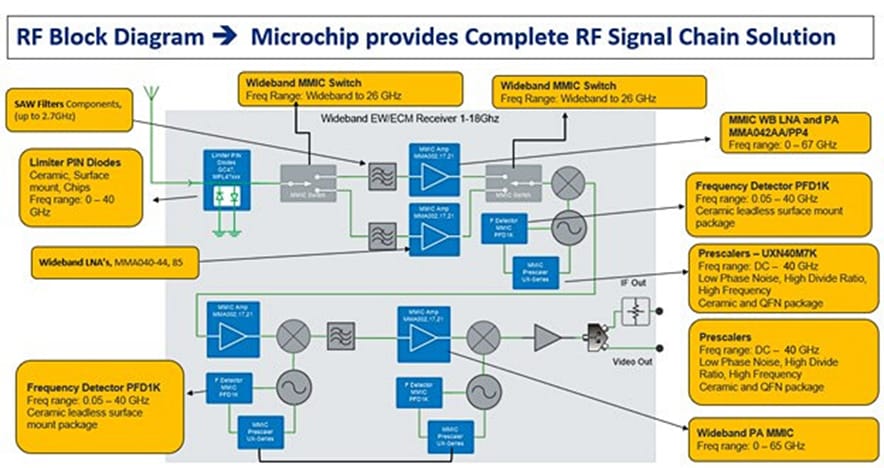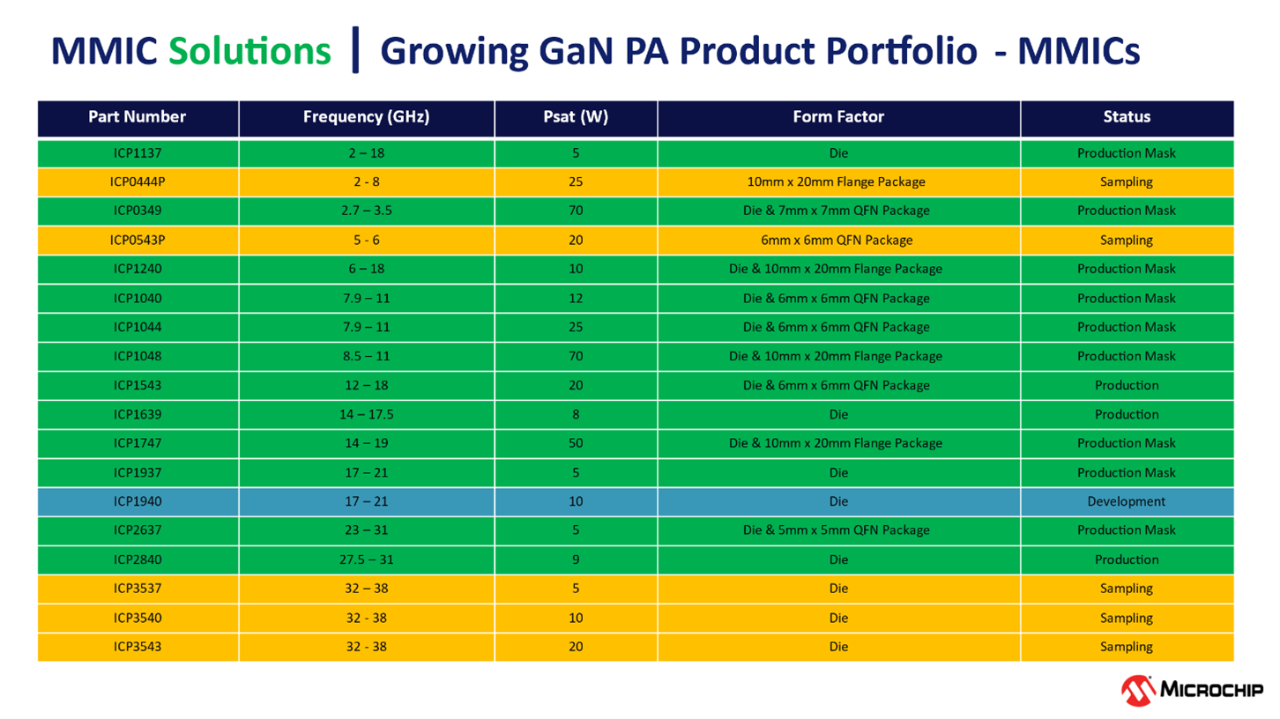High-Efficiency RF Power Amplifiers: Meeting the Demands of Modern Wireless and Satellite Systems
Advancements in RF power amplifiers, especially with GaN-on-SiC technology, are crucial for meeting the increasing demands of modern communication systems, including satellite communications, 5G networks and military applications. The development of sophisticated beamforming techniques and optimized RF signal chains enhances the efficiency and reliability of these systems, providing faster and more efficient communication technologies.

RF systems require power amplifiers (PAs) to deliver linear, efficient, high-output power. As systems transition to higher-order modulation schemes like 64/128/256 Quadrature Amplitude Modulation (QAM), they must maintain high linearity and efficiency in denser environments with stringent peak-to-average power ratios (PAPR). The latest generation of Gallium Nitride (GaN) on Silicon Carbide (SiC) Monolithic Microwave Integrated Circuits (MMIC) PAs addresses these challenges by offering the highest power density, enabling high linear output power with high efficiency.
RF Power Amplifier Opportunities and Challenges
The most significant growth opportunities and challenges for RF power amplifiers lie in satellite communications and emerging 5G solutions. NASA has facilitated the launch of thousands of low-Earth-orbit (LEO) satellites by private companies, providing broadband Internet access, navigation, maritime surveillance, remote sensing and other services. These RF applications consistently seek benefits in size, weight, power and cost (SWaP-C). Phased array antennas are replacing large dish antennas for satellite communication, necessitating smaller and lighter components. High RF power, which is linear with high P1dB and IP3, reduces distortion and is efficient with high PAE to minimize power consumption, essential for these RF applications.
Millimeter-Wave 5G Communications
New generations of millimeter-wave 5G communication solutions, with their speed, ultra-wide bandwidth and low latency, significantly enhance real-time decision-making and other military applications. While 5G systems operating in lower frequency bands (sub 6 GHz) are vulnerable to high-power jamming signals, 5G millimeter-wave (24 GHz and above) systems are less susceptible and are being deployed for both battlefield and non-battlefield applications. Examples include battlefield sensor networks for command-and-control data gathering and augmented reality displays for pilots and infantry soldiers. 5G will also enable virtual reality solutions for remote vehicle operation in air, land and sea missions, as well as various smart warehouse, telemedicine and troop transportation applications off the battlefield.
5G Network Architecture
The 5G network consists of macro base stations and small cells. The macro base station connects to the core network using mmWave backhaul or fiber optic links and can communicate directly with user equipment cell phones or small cells, which provide the last mile connectivity. Picocells and femtocells enhance network connectivity inside buildings where the connection might be weak or have high user density. Femtocells, typically user-installed, improve coverage in small areas like home offices or dead zones within buildings, supporting only a few users with very low output power. Picocells offer greater capacity and coverage, supporting up to 100 users over a range of up to 300 meters, and are often deployed indoors to improve wireless and cellular coverage. Macro base stations cover large areas and have high output power.
Radar Communications
Radar systems operate in various frequency bands for different applications. The L band (1 GHz to 2 GHz) is used for "identify friend or foe," distance-measuring equipment, and tracking and surveillance. The S-band (2 GHz to 4 GHz) is used for selective response Mode S applications and weather radar systems. The X Band (8 GHz to 12 GHz) is used for weather and aircraft radar, while the C Band (4 GHz to 8 GHz) is used for 5G and other sub-7 GHz communications applications. 5G mmWave provides the highest bandwidths and data rates, operating in 24 GHz and higher frequency bands. Satellite communications for LEO and geosynchronous communication operate in the K band, spanning 12 GHz to 40 GHz.
RF Beamforming
Different types of phased array beamforming architectures used in RF applications include analog, digital and hybrid beamforming.
- Analog Beamforming: Involves phase shifters that perform beamforming by changing the phase to achieve constructive interference for receiving and transmitting signals. This method is sensitive to interconnect losses but requires fewer components and has lower power dissipation.
- Digital Beamforming: Provides more precision as beamforming is done in the baseband, but requires an ADC/DAC for each phased array element, resulting in higher power dissipation and more components.
- Hybrid Beamforming: Combines digital and analog beamforming, optimizing larger phased arrays for efficiency, power dissipation and precision.
RF Signal Chain
The RF signal chain involves several stages, including receiving the RF signal through an antenna, amplifying it with a low noise amplifier, down-converting it using a mixer and processing it at the baseband. At the transmitter, the baseband signal is upconverted to the desired RF frequency and amplified using a power amplifier.

Power Amplifiers Requirements
Power amplifiers must operate in their linear region to minimize RF distortion, especially for satellite communications systems using higher-order modulation schemes like 64/128/256 QAM. Achieving a satisfactory peak-to-average power ratio (PAPR) is crucial, as it determines data transmission capacity and is proportional to average power. GaN-on-SiC power amplifiers meet these challenges for satellite communication, 5G, aerospace and defense applications.
GaN-on-SiC Power Amplifiers
GaN-on-SiC technology offers the highest power density, enabling high linear output power with high efficiency. These power amplifiers can operate at high frequencies in the Ka and Ku bands (12 GHz to 40 GHz) for satellite communication and 5G, providing broad bandwidths, high gain and better thermal properties. Our ICP2840 device, operating in the 27.5–31 GHz range, delivers continuous wave (CW) output power of 9 watts and pulsed output power of 10 watts with a gain of 22 dB and power added efficiency of 22%.
Expanding Our Innovative GaN Power Amplifier Portfolio
We are continuously expanding our innovative GaN power amplifier product portfolio to meet the evolving needs of our customers. This chart displays our current offerings, providing a comprehensive overview of the available products designed to support your specific design requirements. Our GaN power amplifiers are engineered to deliver superior performance, efficiency and reliability, making them suitable for a wide range of applications. Whether you are working on wireless infrastructure, satellite communications, radar systems or industrial applications, our diverse product lineup is tailored to help you achieve your design goals with cutting-edge technology.

Conclusion
The advancements in RF power amplifiers, particularly with the integration of GaN-on-SiC technology, are pivotal in addressing the growing demands of modern communication systems. As RF systems evolve to support higher-order modulation schemes and denser environments, the need for high linearity, efficiency and power density becomes increasingly critical. GaN-on-SiC MMIC PAs offer a robust solution, providing the necessary performance enhancements for satellite communications, 5G networks and various military applications. The development of sophisticated beamforming techniques and the optimization of RF signal chains further contribute to the efficiency and reliability of these systems. As the industry continues to innovate, the deployment of advanced RF power amplifiers will play a crucial role in enabling faster, more reliable and more efficient communication technologies, meeting the stringent requirements of both current and future applications.